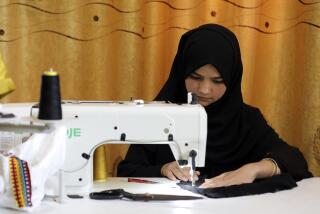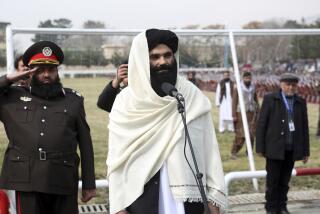One army, many battles
- Share via
Kandahar, Afghanistan — THE commander of Afghan troops confronting the Taliban here is a career officer with a clipped gray beard and a formal bearing who once fought for a Soviet-backed puppet government. His deputy is his former enemy.
Many of their soldiers fought for or against the Russians, against the Taliban or for various warlords -- except those so young they had never picked up a rifle.
From this unwieldy mix, the U.S. military and the Afghan government are attempting to create something Afghanistan has never had: a national army that is made up of all the country’s ethnic groups and represents a unified central government.
Five years after the fall of the Taliban government, thousands of well-armed insurgents have reemerged to seize large swaths of southern Afghanistan.
In many districts, warlords, opium dealers and corrupt police help the religious extremists exert authority. Except for their fortified, American-built bases in the south, Afghan army units control virtually no territory, and they depend totally on the Americans for supplies and support.
The continued presence of foreign troops, who repeatedly have killed Afghan civilians by accident, and the U.S.-backed government’s failure to improve the quality of life or rein in local warlords angers Afghans, pushing some of them back into the arms of the Taliban.
“People are very upset and disappointed with the government,” said Col. Abdul Raziq, a brigade commander in southern Afghanistan.
Officers of the new Afghan army know that the Taliban hold will not be broken until they can establish enough security for the government to provide essential services. Until they do, U.S. and North Atlantic Treaty Organization forces won’t be able to go home.
But with fighting escalating and the Afghan army entirely dependent on the U.S. military, the day when foreign troops can leave seems a long way off.
The army is important for reasons beyond security. Afghanistan has no unifying institutions. The government of President Hamid Karzai controls Kabul but little else. The national police force is notoriously corrupt and, in the hinterlands, often loyal to warlords or opium merchants.
Instilling loyalty to the national government will require changing the nature of Afghanistan. The army is a place to start.
“To the Afghan people, the words ‘Afghan national army’ are sweet words,” said the Afghan commander here, Maj. Gen. Rahmatullah Roufi, 49, whose 205th Corps is responsible for six volatile southern provinces. “They’ve never had a real national army before, only tribes and militias. There’s a hunger for it.”
His deputy, Brig. Gen. Khair Mohammed, 50, said officers were willing to forget the past. Mohammed, a trim, energetic man, gestured toward one of his battalion commanders, who drew to attention and saluted.
“He was a communist, and I fought against him,” Mohammed said. “But that was the past, and we Afghans don’t look back. Now we’re all brothers, all Afghans, and that’s the way of the future.”
Relying on Americans
THE army has been built from scratch since U.S. trainers arrived at the end of more than 20 years of warfare that swept up Roufi, Mohammed and many men of their generation.
It has grown in the last five years to 36,000 trained soldiers and officers, more than halfway to the goal of 70,000 men. The troops enjoy productive relations with 1,200 U.S. and NATO trainers at 85 bases. A few battalions now take the lead during combat operations. Searches of towns and villages are conducted by Afghan soldiers, not American troops.
But the army is still directed and supplied by U.S. and NATO forces. U.S. officers say they plan operations jointly with Afghan commanders, but some Afghan officers say the Americans dictate the scope of operations by controlling supplies, vehicles and air support.
Uniforms, trucks, fuel, food and ammunition are provided by the U.S. Equally important, the Afghans rely on Americans for air support, attack helicopters, artillery and air medical evacuation. And U.S. officers are clearly in command.
Nor do the Afghans control media coverage. U.S. officers blocked Times journalists from being embedded in an Afghan unit, despite approval by Roufi and the Afghan Defense Ministry.
Roufi complained that his authority had been undermined. “It’s frustrating to me, and kind of shameful as well,” he said.
Afghan privates and generals alike complain that they are sent into battle in ordinary Ford Ranger pickups with no body armor or helmets, while U.S. soldiers wear flak vests and travel in armored Humvees.
Raziq said his military communications equipment was so bad that he relied on his own cellphone.
The Afghans disparage their weapons, generally old and balky AK-47s collected from the private armies of warlords.
“Our enemy’s weapons are much more modern than ours,” said Roufi, who commands about 7,000 men.
“We fight on the same ground and under the same threat as the Americans and the coalition, but we don’t have what we need to operate independently. This has a poor effect on our soldiers’ morale,” said Gen. Zahir Azemi, the army’s chief spokesman.
U.S. soldiers, except when sent out on combat missions, live in air-conditioned barracks with cable TV and Internet access. They eat in modern dining facilities that are more like shopping-mall food courts than mess halls.
By contrast, most Afghan soldiers live in poorly maintained buildings, where some men segregate themselves by ethnicity. In the barracks behind Roufi’s headquarters in Kandahar, his men cooked lamb and rice on the floor, next to a laundry drain. In the bathroom, mud smeared the showers, and sinks were clogged with food scraps and garbage.
With their scruffy beards and slender frames, the Afghans appear to lack the fitness and discipline of their U.S. counterparts. Although their Afghan-made uniforms are paid for by the U.S. and similar to the ones worn by American troops, some Afghans are more comfortable wearing slip-on loafers than combat boots. Afghan soldiers also tend to prefer traditional scarves to helmets.
U.S. trainers, while praising Afghans for their courage, complain of lax discipline, petty thefts and poor maintenance of weapons and equipment. The Afghans will often run up hills or charge into caves wearing virtually no armor and without waiting for backup. And while U.S. troops are stoic and focused during combat missions, many Afghans are freewheeling and talkative.
The trainers constantly urge Afghan commanders to discipline their men. They say at least two bases have been abandoned by Afghan units after American trainers were transferred out.
For American troops, the Afghans’ blase attitudes toward supply lines, coordinated planning or maintaining effective communications can be maddening.
“These guys fight magnificently. They run to the fight, not away from it,” said Col. Michael “Jeff” Petrucci, who is Roufi’s counterpart and mentor. “But they cannot sustain operations over a long period.”
Lt. Jason Elphick, a U.S. trainer, said Afghan soldiers tended to operate “hour by hour” rather than planning ahead. They work hard in the mornings, he said, but in the afternoon, when U.S. trainers want them to clean and maintain their weapons, “all they want to do is nap.”
Some critics say disbanding the Afghan militias that initially dominated the army robbed the force of experienced mujahedin fighters. Under a United Nations-sponsored disarmament program, the militiamen were demobilized and trained for civilian jobs. Critics say that left the army dependent on young recruits with no combat experience.
The roughly two years needed to replace militiamen with recruits has given the Taliban time to reestablish itself in the south, its traditional power base, said Ismail Khan, a Tajik warlord who commanded a powerful militia that was largely disbanded when he was appointed energy minister.
“The one force that knew how to defeat the Taliban was disarmed,” he said.
Asked whether he had faith in the army to defeat the Taliban, Khan thought for a moment and replied, “No.”
‘Not just one tribe’
THE typical army recruit arrives at a training center in Kabul in a baggy tunic and trousers, his possessions crammed into plastic shopping bags. He has no other job prospects and no military experience. More likely than not he is illiterate.
Asadullah Jalal Abad, 19, a fresh-faced Pashtun from a rural eastern village, said he signed on because he was tired of working as a day laborer in Pakistan. But he also wants to serve his country by providing security for all of its ethnic groups, he said.
“In my village, people want the army to come there. They know it serves everybody, not just one tribe,” Abad said the day he arrived at the Kabul training center, where he was eager to learn how to fire a rifle.
Lyagat, 25, a Pashtun who, like many Afghans, uses one name, arrived the same day, having given up a job as a driver.
“I don’t even know how much the army pays, but it doesn’t matter,” he said. “I want to help protect my country. It’s a very young country and needs my help.”
Lyagat said he had assumed that units were segregated by ethnic group but was pleased to learn that he would not be serving strictly with Pashtuns.
“I found out it’s not the Pashtun army or the Tajik army,” he said. “It’s the national army.”
The Kabul center turns out 1,000 trained recruits a month on hot, dusty fields where the Afghans flop on their bellies and fire at distant targets. Training has been increased from six weeks to 15 weeks, and the size of trained battalions from 400 men to 1,200.
More so than in Iraq, the Afghan army is designed to reflect the country’s ethnic balance. U.S. and Afghan commanders say the army’s ethnic makeup generally matches the national population -- about 42% Pashtun, 27% Tajik, 9% each Hazara and Uzbek, and numerous smaller groups.
In Iraq, the national army is dominated by Shiite Muslims, many loyal to Shiite militia commanders. The Afghan army at first incorporated Tajik-led militias of the Northern Alliance, the U.S.-backed warlords who helped defeat the Taliban. And initially, the defense, interior and foreign ministries were held by Northern Alliance Tajiks. Now Pashtun, Hazara and Uzbek officers have filled some commands once held exclusively by Tajiks, U.S. and Afghan officers said.
Roufi and Mohammed are Pashtuns, as is Defense Minister Abdul Rahim Wardak.
Although many young men join to serve their country, Roufi said, the army’s main attractions are steady, if low, wages, a place to live and ample food.
“These are very poor young men, and this is a good life for them,” Roufi said. “And most Afghans have never had any discipline. They get discipline here, and they find it agreeable.”
The pay is meager. A first-year Afghan soldier earns $70 a month, less than a common laborer. The top enlisted man makes $180 a month, a major $300, a colonel $400 and a general $530.
Although the army has attracted more than enough recruits, the low pay means that many of them won’t reenlist when their three-year tours are up.
“For every 1,000 recruits who graduate from basic training, at least 500 will leave after three years to find other work -- either in Afghanistan or Pakistan or Iran,” Raziq said.
Soldiers often disappear for days or weeks while making their way home to give money to their families. Afghanistan has no national banking system, so soldiers are paid in cash. In some battalions, soldiers claim, commanders skim cash for themselves. In others, the cash arrives several weeks late.
Some soldiers return weeks later, expecting to rejoin their units and get paid as if they had never left.
Some soldiers have quit and returned home to protect their families from retaliation by the Taliban. Commanders say it is a pervasive threat.
Roufi said his wife and children lived in Kabul, protected by his extended family. Mohammed lives with his wife and eight children in a bombed-out former Soviet apartment complex, guarded by soldiers on the Afghan military base in Kandahar.
“Everyone in the command worries about threats to their families. These threats are very real,” Roufi said. Several soldiers said an officer who recently returned to Kabul to check on his family was captured and hanged by the Taliban.
Brig. Gen. Douglas Pritt, a member of the Oregon National Guard who commands the training effort, said the low retention rate was the Afghan army’s biggest problem. The U.S. is working to improve weapons and equipment, he said, and Afghans should be working to offer reenlistment bonuses and pay increases.
“Here’s what I tell the [Afghan] corps commanders: ‘I understand your desire for better and more equipment. That will happen. But right now the biggest issue facing you is retaining soldiers,’ ” Pritt said. “ ‘You need to focus on that ... take care of them so that their basic needs are met so that they aren’t inclined to leave.’ ”
A formidable enemy
FOR centuries, Afghans have adopted guerrilla tactics to defeat invaders. U.S. trainers want them to do the opposite, learning to fight as a modern counterinsurgency force. As the Afghans have absorbed those lessons, the insurgency has gained strength.
Fighting the Taliban on its home turf is proving troublesome. Even Afghan soldiers have difficulty distinguishing civilians from Taliban fighters.
Taliban fighters have funneled weapons and supplies from Pakistan as they emerged from hiding in towns and villages across the south. They have built an elaborate network of caves and tunnels to ambush Afghan and foreign troops and then disappear. They attack in larger groups and are mounting bolder operations.
“The intensity of the [Taliban] threat is infinitely worse than just a year ago,” Petrucci said. “Now the Taliban will mass, they will maneuver and they will not break contact like they used to. They’ll grab you by the belt, and they won’t let go.”
The Taliban controls southern districts through intimidation and terror, Afghan commanders say, and the army cannot protect civilians from reprisals.
The Taliban also has built alliances of convenience with opium dealers and warlords. Corrupt district commissioners, nominally loyal to the central government, also help the insurgents, Roufi said.
“These are the real snakes in the sleeve,” Roufi said of the commissioners.
Brigade Sgt. Maj. Kefaitullah, the top enlisted man in an Afghan unit here, said the Taliban capitalized on the frustration ordinary Afghans felt toward the government, particularly over civilians killed by U.S. forces.
Taliban spies and sympathizers have infiltrated the army, providing or selling information, U.S. and Afghan officers said. Local men monitor the main gate of the Kandahar base, using cellphones to alert Taliban fighters of approaching U.S. and Afghan army convoys.
Capt. Andre Sison, a U.S. trainer, said he didn’t trust all Afghan soldiers. “But the ones I train in my company, I trust enough to go out with them every day on combat ops,” he said.
Asked whether the army had been infiltrated, Pritt said: “Certainly I think so. But I know of no situations in which information was directly leaked that compromised an operation.”
To help prevent leaks, rank-and-file soldiers are not told beforehand of the times, dates and locations of operations, Pritt said. The U.S. uses other countermeasures, he said, including putting out false information and monitoring communications to see if it’s passed on.
Taliban fighters use call signs and code words in radio communications, something U.S. trainers are trying to teach the Afghan army to do, Sison said. Too often, Afghan officers simply shout commands into their radios.
Roufi said it worried him that his enemy had adopted successful tactics used by Iraqi insurgents, including roadside bombs, suicide bombings and assassinations of government officials.
There were just two suicide attacks in Afghanistan in 2002, six in 2004, 21 in 2005 -- and 91 so far this year. Roadside bombs are becoming larger and more effective. Of the 29 soldiers in his corps killed in the previous month, Roufi said, most were hit by roadside bombs. Two days earlier, three of his men had been killed by a roadside bomb.
Kandahar and other southern provinces were the Taliban’s stronghold.
“They’ll do anything to get it back,” Roufi said.
As he spoke, a convoy of Ford Rangers roared up to his command center, the trucks coated in dust as soldiers returned from a combat mission. The general pointed out that the men wore no vests or helmets and that the Rangers were ordinary pickups. He said his soldiers would need better equipment before they could even think about operating without U.S. support.
“That truck is like a piece of tissue paper,” he said. “If a bomb explodes, everyone inside will die. An armored Humvee would be much better.”
*
About this series
Afghanistan’s struggling institutions are key to the future of its democracy:
SUNDAY
President Hamid Karzai is limited by a lack of control over the military and his budget.
TODAY
The army is inclusive, but it depends on the U.S. for supplies and logistics.
Additional articles will appear in coming weeks.
Read the previous installment at latimes.com/afghan.
More to Read
Sign up for Essential California
The most important California stories and recommendations in your inbox every morning.
You may occasionally receive promotional content from the Los Angeles Times.














